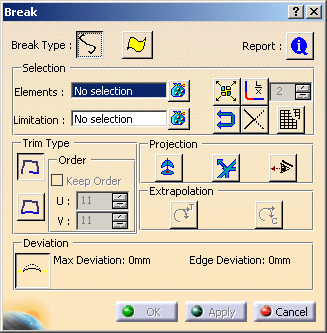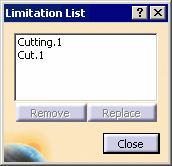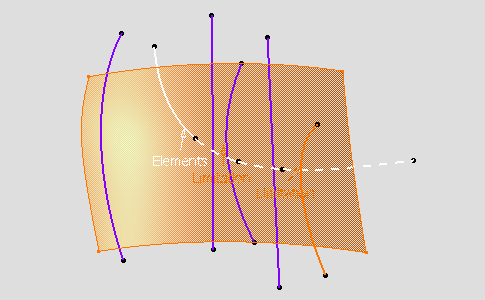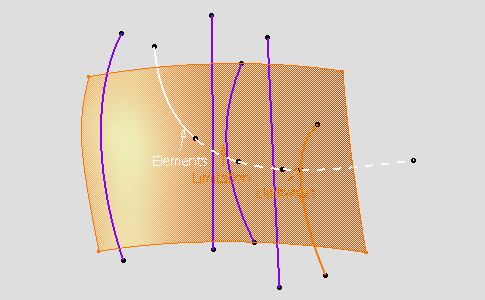 |
-
Click the Break Surface or Curve icon:

| The Break dialog box and the Tools Palette
appear. |
-
Select the Break Curves option if needed:

| The Break dialog box content has been modified according
to the selected type. |
 |
The Break dialog box displays the following information:
-
Break Type:
-
Selection
-
Elements: defines the set of curves or surfaces
to be cut.
-
Limitation: defines the set of limiting elements
such as
points, curves, planes or surfaces.
-
 Break Both: breaks elements to be cut and
limiting elements by each other.
Break Both: breaks elements to be cut and
limiting elements by each other.
-

-

-
-
Trim Type:
-
 Edge Trim: curves are topologically relimited and the
control points of the initial curves are kept.
Edge Trim: curves are topologically relimited and the
control points of the initial curves are kept.
-
 Curve Trim: curves are geometrically relimited and the
control points of the resulting curves are kept.
Curve Trim: curves are geometrically relimited and the
control points of the resulting curves are kept.
-
Order
-
U: defines the U order.
Available only with
Break Surfaces and Surface Trim
options.
The U and V order maximum values are set with the
Order
setting option of the FreeStyle settings.
-
V: defines the V order.
Available only with
Break Surfaces and Surface Trim
options.
The U and V order maximum values are set with the
Order
setting option of the FreeStyle settings.
-
Projection: By default the points that do not lie on
the trimmed elements will not be projected onto the trimming elements.
-
 Along Compass: projects along the compass direction.
Along Compass: projects along the compass direction.
-
 Along Normal: projects along the normal direction.
Along Normal: projects along the normal direction.
-
 Along Viewing Direction: projects along the viewing
direction.
Along Viewing Direction: projects along the viewing
direction.
-
Extrapolation:
-
 Tangential Extrapolation: extrapolates along the tangent
direction.
Tangential Extrapolation: extrapolates along the tangent
direction.
Available only with Break Surfaces option.
-
 Curvature Extrapolation: extrapolates along the curvature
direction.
Curvature Extrapolation: extrapolates along the curvature
direction.
Available only with Break Surfaces option.
-
 Report: displays a status about cutting elements:
Report: displays a status about cutting elements:
-
Cutting elements that can be used for the Break (marked by a
green tip). When you click on the text, the corresponding curve
is highlighted in green in the 3D geometry.
-
Cutting elements that cannot be used for the Break (marked by
the condition to be applied so that they can be used: projection,
etc). When you click on the text, the corresponding curve is highlighted
in red in the 3D geometry.
-
When there is no selection of cutting elements, an error message
is issued and the Break Report panel informs you that
no element is selected.
-
When a red cross is displayed, it means that the problem cannot
be managed by the application.
-
Max deviation: displays the maximal deviation
between original surface and the resultant surface in the dialog box
and on the geometry. This is available only with Break Curves and
Trim Surface
options.
|
-
Select the curve.
-
Select the Cutting field in the Break
dialog box and select the surface and the curve as shown.
-
Click the Limitation List icon:

| The Limitation List dialog box appears. You can manage inside
this dialog box the limiting elements: remove or replace. |
 |
-
Click Close in the Limitation List dialog box.
-
Click Apply in the Break dialog box.
| Only the white elements are trimmed. By default, only one
trimmed element is kept (plain line) other not (dashed line). |
 |
-
Click the curve segment to be kept: it
appears with a plain line in the 3D geometry.
-
Right-click any relimited element to display the following
contextual menu.
 |
- Keep all: all parts of the all curves are kept.
- Keep all but this: all parts of all curves are kept
except the selected one.
- Remove all but this: all parts of all curves are removed
except the selected one.
|
|
To keep, or do not keep, some elements press the Ctrl key and click them. |
-
Click the Along Compass option:

-
Click Apply in the Break dialog box.
| Elements that do not lie on the trimmed elements will be projected
(pseudo-intersections) onto the trimming elements according to the compass
direction. |
 |
-
Click OK in the Break dialog box.
|
![]()